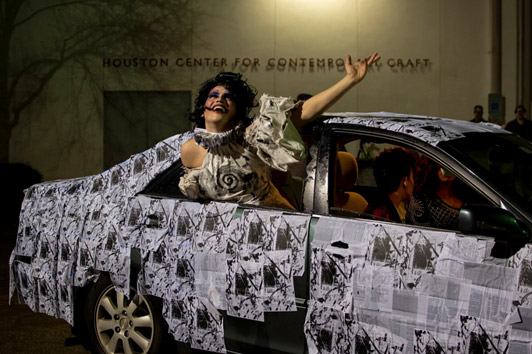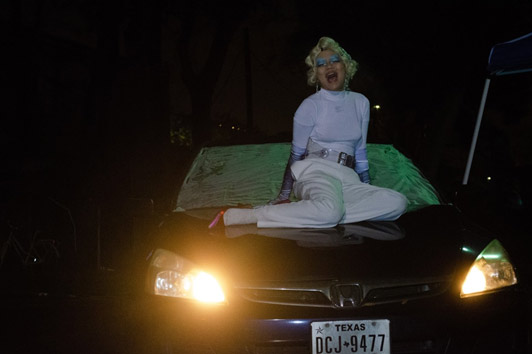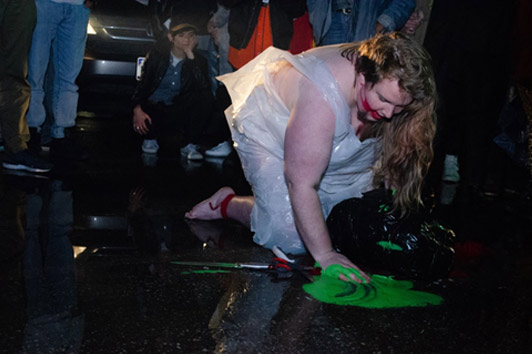“Queer(ing) the Wheel,” presented on February 21, 2019, at Houston Center for Contemporary Craft, was the brainchild of resident artist Antonius-Tin Bui and collaborator Tonya Hyunh. Inspired by the historic Playhouse Theater located next door to HCCC on Main Street, this performance harnessed the concept of the immersive “theater-in-the-round” to engage audiences in an exploration of queer identity and mobility in Houston. On the 68th anniversary of the Theater’s opening night, the event featured Antonius-Tin Bui (performance and craft), Emilý Æyer (sound and performance), S Rodriguez (sound and interactive performance, queer sci-fi literature), Devin Kenny (multidisciplinary sculpture), Junior Fernandez (photography), Post Modern Sleaze (performance), and Duke Diesel (performance). HCCC Curatorial Fellow María-Elisa Heg interviewed Bui and Hyunh to learn more about what inspired this project and its significance to the queer community.

María-Elisa Heg: Tell us a little bit about how this performance came about and how you first encountered the Playhouse Theater.
Antonius-Tin Bui & Tonya Huynh: What does the archive mean in the 21st century? Who has access to archives? Who is in charge of defining the mission and intentions of an archive? Who is forgotten and erased from the archives?
This performance seems to be the physical manifestation of our ongoing conversations around queerness, liminality, and archives. We were also inspired by Guy Debord’s concept of psychogeography, the study of a geographic environment’s impact on the emotions and behaviors of an individual. Psychogeography calls for the dissolution between art and life through playful strategies that take community members off their usual paths, bringing forth new awareness of the landscape.
MH: At the time of its inaugural performance on February 21, 1951, the Playhouse was one of the largest theaters-in-the-round in the nation. However, it only operated for two years before shutting down due to lack of funds. The ambitious scale and tragically short life of the Playhouse Theater make for interesting reading, but what is it particularly about the Playhouse’s history that inspired you to create your unique variation on the concept of theater-in-the-round?
AB & TH: José Esteban Muñoz defines queerness as a horizon of being that can be glimpsed in utopian bonds, affiliations, designs, and gestures that exist within the present. This includes art, writing, political protest, performance, public sex, and theater.
As queer artists of color, we saw parallels between the ever-changing lives of Playhouse Theater and the horizons of queerness. Even though Playhouse Theater only operated for two years, it took on multiple lives after being shut down, later becoming Academy Theater, as well as the National African American Museum. Both queerness and the Playhouse Theater continue to evolve.
On a starker note, we saw the similarities between the careers of artists and Playhouse Theater. Artists will continuously be displaced and forgotten if we are not properly valued and compensated for the work that we do.

MH: Can you talk about the significance of having cars being the “vehicles” that carry the installation and performances presented in Queer(ing) the Wheel?
AB & TH: We immediately bonded over how necessary our cars are to our physical, emotional, and psychological well-being as queer Vietnamese-Americans the first time we met. They are our second homes, providing space to openly be ourselves amongst the company of those we allow in. Our vehicles are a living archive of our queer existence, providing glimpses into how we navigate a heteronormative world that still condemns LGBTQIA+ folx.
At the same time we are conflicted by our dependency on the oil and gas industry in order to survive. What does it mean to be funded and supported by institutions that are built on an industry that actively destroys our environment?
MH: What should people expect to see and experience at Queer(ing) the Wheel? Do you have any suggestions for newcomers to performance art on how they can connect with this piece and with performance art in general?
AB & TH: A bang for your free buck! Ha ha. Seriously though, we simply ask that audience members take time to be present with each artist’s piece. It’s ok, if not encouraged, to be uncomfortable with performance art. The audience’s energy and participation often times completes the work, bringing forth more questions than answers.
MH: Antonius, although you are a multidisciplinary artist, you have focused on paper during your time as a resident artist at HCCC. It might surprise some people to learn that you have a strong performance background. Would you talk a little bit about how your work in the world of craft and the world of performance overlap, or don’t, and how this performance piece speaks to the themes you address in the work you displayed at Lawndale Art Center, in your show yêu em dài lâu (me love you long time)?
AB: As an interdisciplinary/undiscplinary artist, I see no boundaries between the work that I create. The way we classify mediums and art forms may be useful for some, but I personally find it quite limiting. Regardless of the materials and techniques I’m utilizing, I find that themes of identity, specifically queerness and the Vietnamese diaspora, are constant threads of my work.
I should also say that I’m quite new to performance art as well! It was my dear friend and colleague, Hoesy Corona, who encouraged me to explore performance less than a year ago. I’m constantly learning and unlearning what performance art can look, smell, sound, taste, and feel like.


